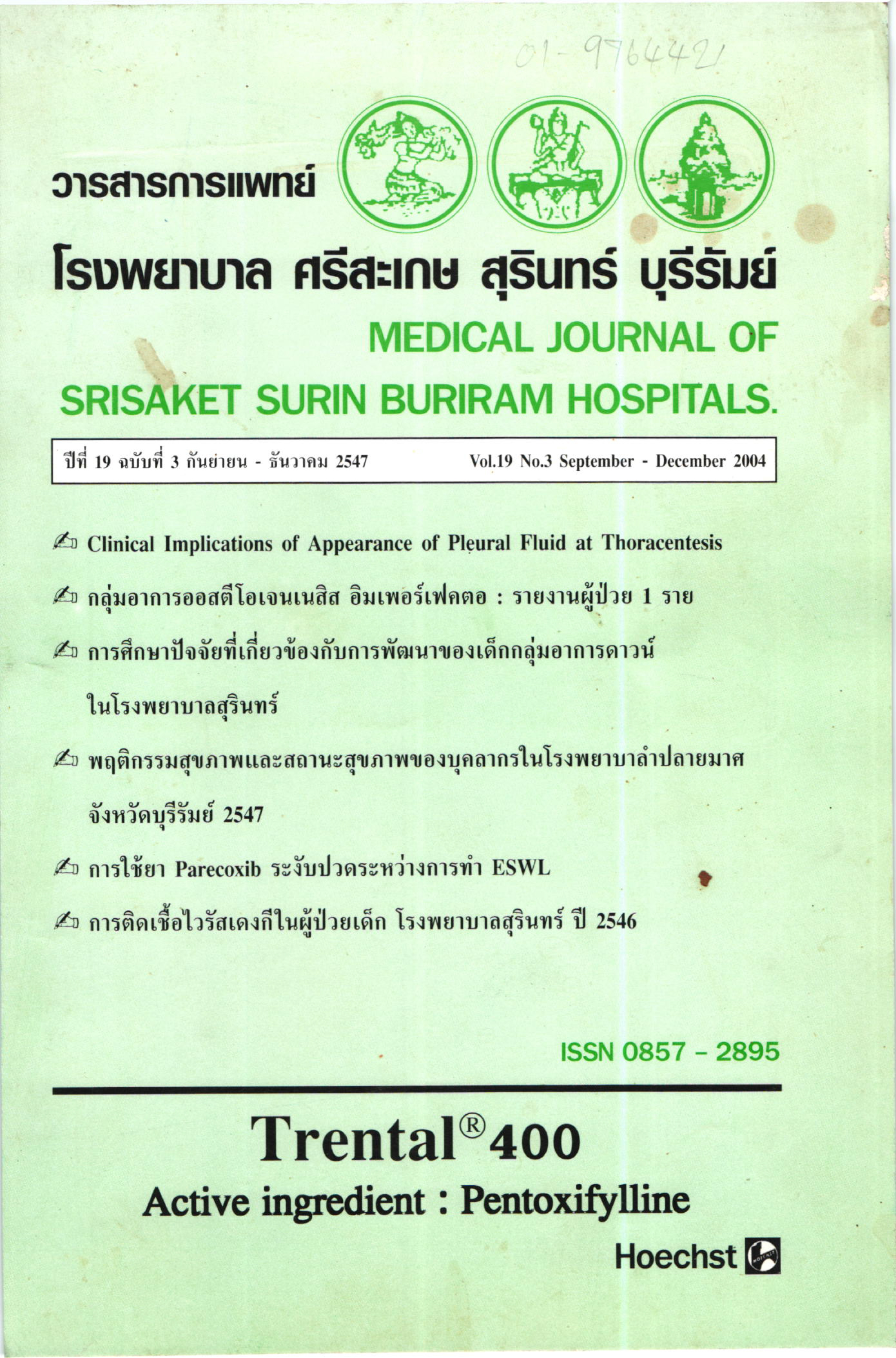Clinical Implications of Appearance of Pleural Fluid at Thoracentesis
Main Article Content
บทคัดย่อ
Study objectives: The aims of this study were to describe the different appearances of pleural fluid during thoracentesis and their frequency in relation to diagnosis, and to evaluate the causes and clinical implications of bloody pleural effusions.
Setting: Secondary care, 600 beds Sunrin hospital.
Subjects and methods: One hundred twenty-four patients with pleural effusion were retrospectively assessed from October 2003 to September 2004.
Results: Pleura! effusions developed in 124 hospital admissions. Their sizes were small (27%), moderate (48%), large (20%), and loculated (5%). The associated conditions were infectious: pulmonary tuberculosis (n = 37), bacterial pneumonia (n = 21), empyema (n = 9), parasitic disesas (n =5) and Dengue hemorrhagic fever (n=2); and noninfectious: paramalignancy (n=9), malignancy (n = 6), hepatic cirrhosis (n = 6), pancreatitis (n = 3), congestive heart failure (n = 3), atelectasis (n = 3), hypoatbu-minemia (n = 2), renal failure (n = 1). The most common presentations were serous and blood tinged, with 82% of the fluids fitting into one of these categories. The most frequent cause of serous fluid was tuberculosis. There were 18 bloody and 67 nonbloody pleural fluids. The most common cause of bloody pleural effusion (BPE) was malignancy (32%). Nevertheless, only 36% of the neoplastic effusions were BPE. Other common causes of BPE were parapneumonic (21%) or parasitic dis-eases(16%) pleural effusions. Tuberculosis was the most common causes of pleural effusion. Fluid that was bloody fluid in appearance, increased the probability for neoplasm and parasitic disease(OR, 3.2; 95% CI, 2.02 to 4.42; p = 0.05 and OR, 5.65; 95% CI, 3.79 to 7.51; p = 0.05, respectively).
Conclusions: Serous and blood tinged were the most common presentations of pleural fluid at thoracentesis. Almost half of BPEs were secondary to neoplasms, but only 32% of the neoplastic effusions were BPEs. Other common causes of BPE were parapneumonic and parasitic diseases.
Key Words: bloody appearance, pleural effusion, pleural tuberculosis
Article Details
เอกสารอ้างอิง
2. Martesson, G, Petterson, K, Thiringer G. Differentiation between malignant and non-malignant pleural effusion. Eur J Respir Dis 1985;67,326-334
3. Villena V, Lo’pez Encuentra A, Echave-Sustaeta J, et al. Prospective study of 1,000 consecutive patients with pleural effusion. Etiology of the effusion and characteristics of the patients. Arch Bronconeumol 2002;38(1):21-26
4. Villena V, Pe’rez V, Pozo F, et al. Amylase levels in pleural effusions: a consecutive unselected series of 841 patients. Chest 2002;121,470-474
5. Villena V, Lo’pez Encuentra A, Echave-Sustaeta J, et al. Interferon in 388 immunocompromised and immunocompetent patients for diagnosing pleural tuberculosis. Eur Respir J 1996;9,2635-2639
6. Adelman M, Albelda SM, Gottlieb J, et al. Diagnostic utility of pleural fluid eosinophilia. Am J Med 1984, 77:915-920.
7. Kuhn M, Fitting JW, Leuenberger P. Probability of malignancy in pleural fluid eosinophilia. Chest 1989,9:992994.
8. Rubins JB, Rubins HB. Etiology and prognostic significance of eosinophilic pleural effusions. A prospective study. Chest 1996,110:1271-1274.
9. Martinez-Garcia MA, Cases-Viedma E, Cordero-Rodriguez PJ, et al. Diagnostic utility of eosinophils in the pleural fluid. Eur Respir J 2000,15:166-169.
10. Bower G. Eosinophilic pleural effusion. A condition with multiple causes. Am Rev Respir Dis 1967,95:746-751.
11. Campbell GD, Webb WR. Eosinophilic pleural effusion. Am Rev Respir Dis 1964,90:194-198.
12. Veress JF, Koss LG, Schrieber K. Eosinophilic pleural effusions. Acta Cytol 1979,23:40.
13. Rajagopalan, N, Hoffstein, V Hemothorax. following uncomplicated sclerotherapy for esophageal varices. Chest 1994;106,314-315.


